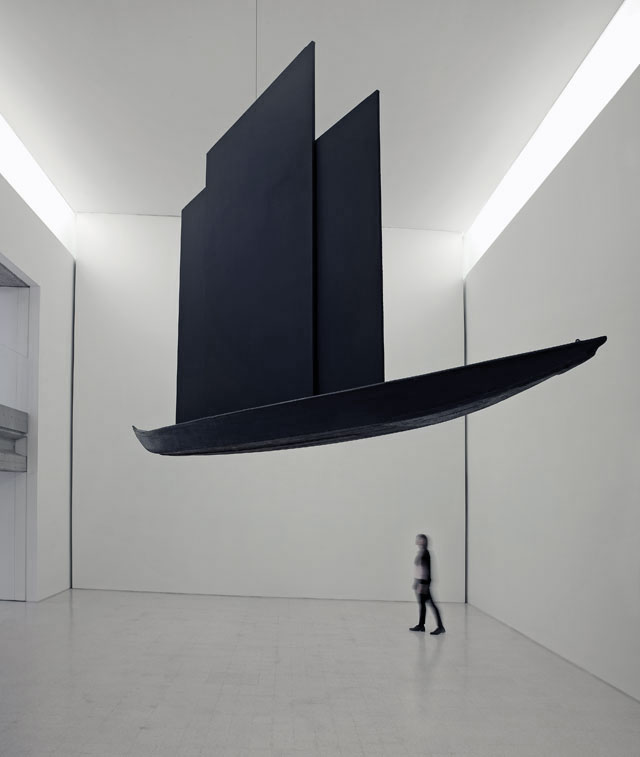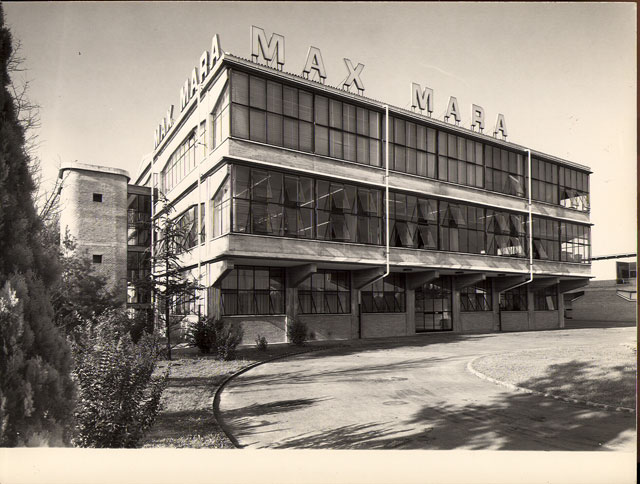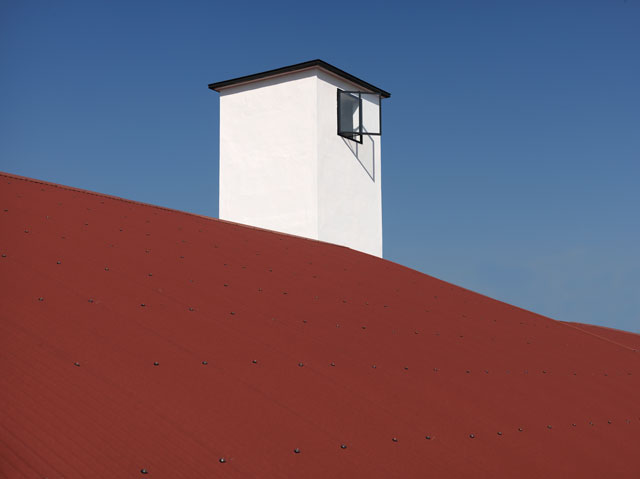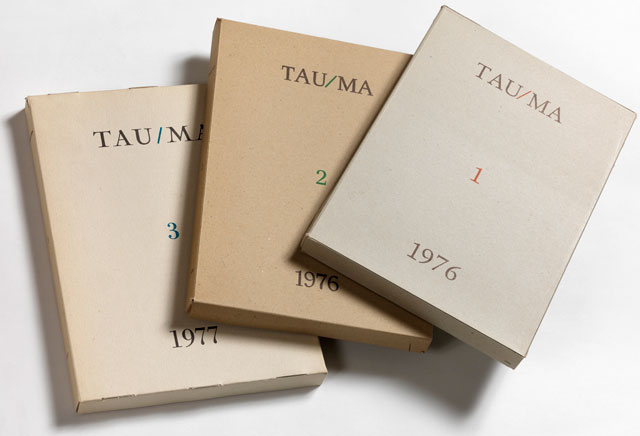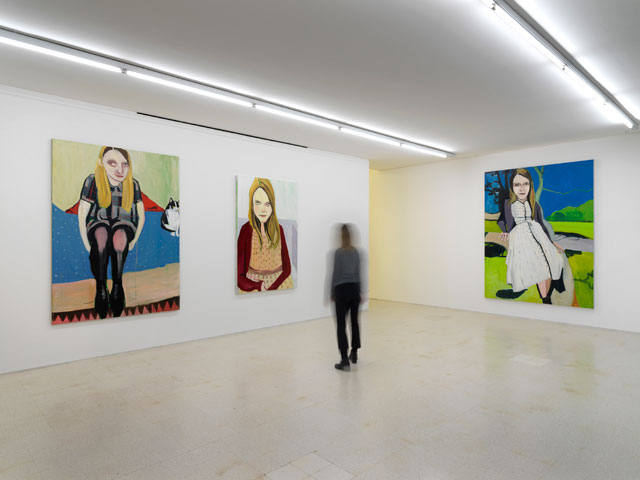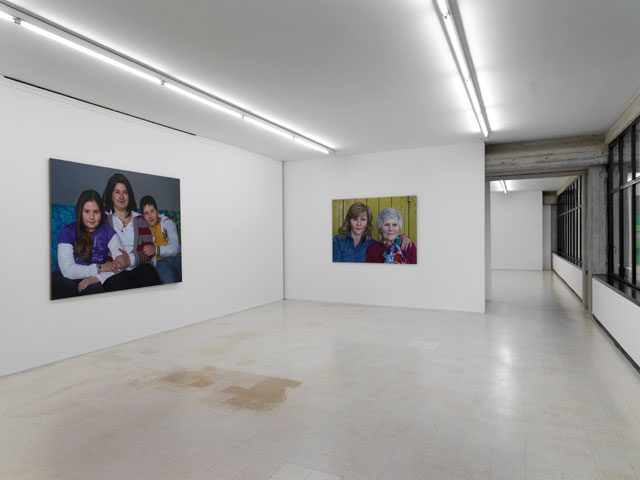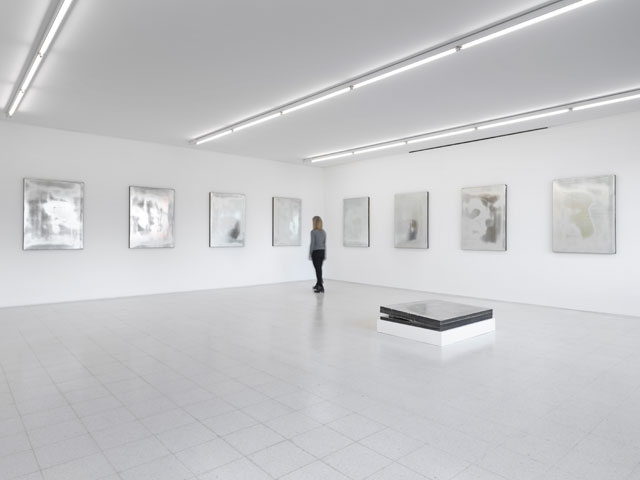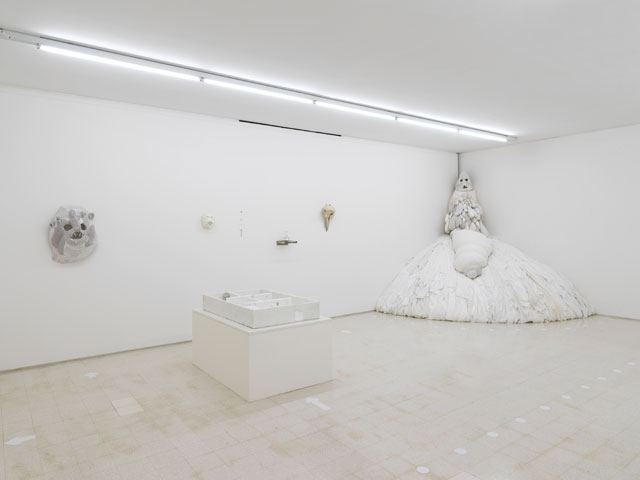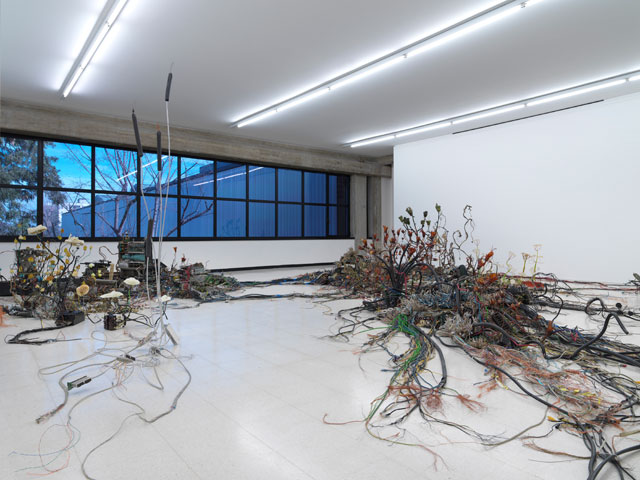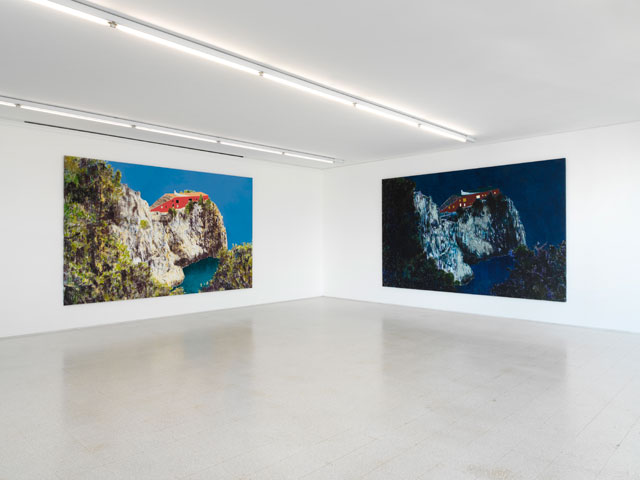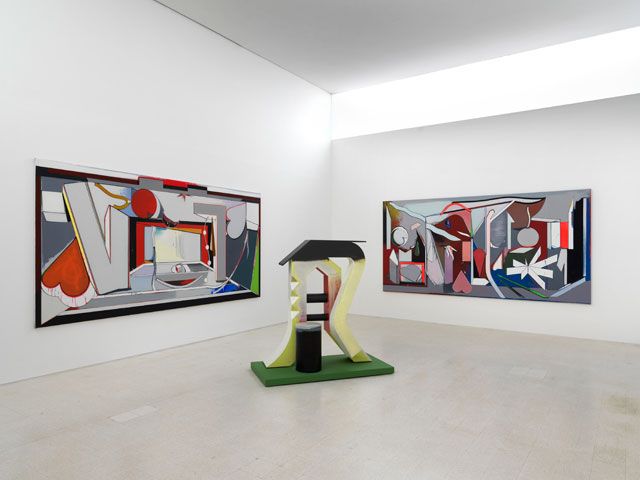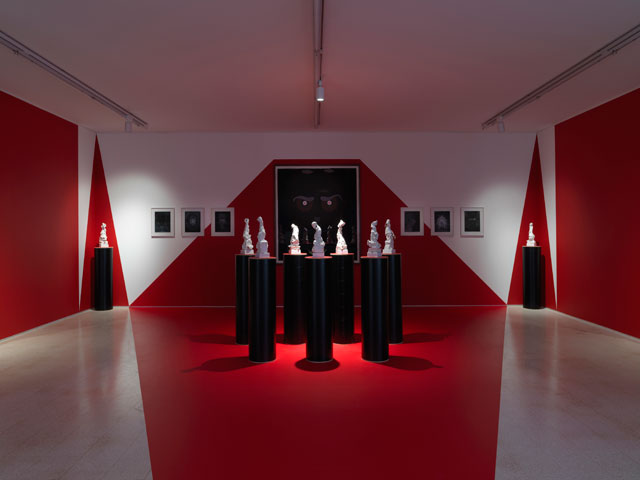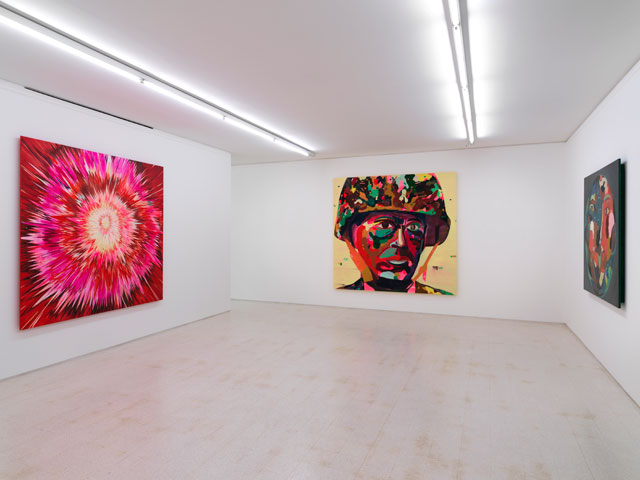

by ROSANNA MCLAUGHLIN
The first time I visited Collezione Maramotti, it is fair to say I wasn’t looking my best. I arrived by early morning train at Reggio Emilia: a city in the north of Italy, where the quiet, classical squares unfold like those in Giorgio de Chirico’s paintings. I had spent the previous night in Rome, drinking more Fernet-Branca than I care to remember. As I strolled through the city, with a sore head and feeling dishevelled, my comfort-hoodie placed me in sharp contrast to my surroundings. Reggio Emilia is the definition of elegance. It is also the home of Max Mara, the fashion brand founded in 1951 by Achille Maramotti, a man who would go on to be tireless art collector.
The Maramotti family are influential in the region. In addition to Max Mara, they own a boutique hotel, a Michelin-starred restaurant, and they produce their own parmesan. They also run Collezione Maramotti: a beautiful example of modern Italian architecture that is home to the family’s extensive private art collection. In the gardens on opening nights, waiting staff with silver trays serve parmesan mousse and tuiles, and crisp, sparkling wine, to guests wearing velvet slippers and embroidered silk coats. (An extraordinary sight for a shabby Londoner like me, and definitely not a place to turn up to wearing a hoodie.)
[image11]
The collection opened to the public in 2007, and it contains a significant body of Italian painting from the 1950s to the present day, as well as a good deal of US art. Visitors can see works by Italian artists Jannis Kounellis, Francesco Clemente and Alberto Burri, as well as by American artists Jean-Michel Basquiat, Cy Twombly and Julian Schnabel. Until now, the display has reflected the tastes of Achille Maramotti, who died in 2005. In the years since his death, his children have followed in his footsteps, commissioning artists to produce new work. This month marks the first time the permanent display will change. Ten rooms will be rehung to reflect commissions produced over the past decade, including work by internationally established painters such as Chantal Joffe and Jacob Kassay, as well as the local artist Alessandra Ariatti. In the run up to the opening, I spoke with Sara Piccinini, senior coordinator of the collection, about the history of the collection, and the thinking behind the rehang.
[image7]
Rosanna Mclaughlin: Collezione Maramotti opened in 2007, in the former headquarters of Max Mara. Where did the idea for the collection come from?
Sara Piccinini: Achille Maramotti had intended to open a collection to the public since the 1970s. He had an idea in his mind that he would share his art with the public, but he couldn’t find an adequate space until Max Mara moved its headquarters to another venue. So, in a way, the project is many decades old, even if it was only realised in the 2000s. Before we opened, most of the works were in storage crates, although some of them were on display in the old Max Mara factory in the common spaces – the corridors and meeting rooms. Visitors to the collection will see that most of the works we have here are very big, and not really intended to be in private homes. You would need huge walls to hang them, so, until the opening, most of them weren’t on display.
RM: Can you tell me about Achille Maramotti? His is a fascinating story.
SP: Achille Maramotti founded the Max Mara company in 1951. In 1957, the original building for Max Mara was built, and it remained the main venue for the company until 2003. This is the building in which the collection is housed today. He was very passionate about art in general, especially painting. Because of this, much of the permanent collection is focused on painting and the development of painterly language. He was also passionate about different periods of painting: early-20th century as well as ancient.
[image2]
RM: When did he start collecting?
SP: He started collecting contemporary art early in the 1960s. The installation of the artworks in the permanent collection follow a chronological order. The very first purchases he made were Osvaldo Licini and Lucio Fontana. In the 1960s, he continued to follow the development of painting in Italy, collecting Cy Twombly, Jannis Kounellis and Italian pop art. In the 1970s, he collected arte povera, and, in the 1980s, Italian expressionism. So he was following what was happening, and he often knew the artists personally. Some of them were close friends.
RM: Which artists in particular was he close to?
SP: Claudio Parmiggiani, for example, who, prior to the rehang, was the only artist from the Emilia-Romagna region present in the permanent collection. He works a lot with poetry, alchemy and philosophy. He was a close friend of Achille, and there was a significant intellectual interchange between the two.
[image4]
In the 1970s, they produced an experimental magazine called Tau/Ma, a magazine in a box that included contributions from different artists and intellectuals who were working at that time, as well as reproductions of alchemical and poetical texts from ancient history. He was also a close friend of Enzo Cucchi, an Italian painter who was part of the Transavanguardia movement, and Jannis Kounellis. Achille followed Kounellis’s work through the decades. We have the very first work of his using numbers and letters from the early 60s.
RM: Did Achille have a specific vision for collecting Italian artists and putting them in dialogue with developments in the arts internationally? US heavyweight painters, such as David Salle, are also included in the collection …
SP: On the first floor of the permanent collection, you will mostly find Italian art from the 1950s to the 1980s. During this time, Achille was exploring new ground. Contemporary art was new to him, and it was a time when art in Italy was lively and strong, especially painting. We had neoexpressionism and pop art, and painters were many and breaking new ground. In the 1980s, after the Transavanguardia movement, Italy went through a time where painting wasn’t as strong any more, so Achille turned his eye to the US. This is why the second part of the permanent collection is mostly US art.
RM: Did the art collection have an influence on the Max Mara fashion house, or vice versa?
SP: The family want to keep the two parts separate. Achille’s children are also collectors and, like him, they are involved in new projects with artists who are young or mid-career. Art for them is something that exists in an autonomous way. It doesn’t depend on any final user. It doesn’t need a reason to exist. Yet it’s true also that Achille displayed art in the corridors of the Max Mara factory. He intended the art to have a positive effect on the designers and other people working for him.
RM: The building that houses the collection is extraordinary: a beautiful, multistorey, concrete and glass structure, and a work of classic modern design. Who designed it?
SP: It was built especially for Max Mara, and the designers were Antonio Pastorini and Eugenio Salvarani, architects from Reggio Emilia. When Max Mara relocated in the 2000s, it was converted by Andrew Hapgood, a British architect. He preserved many of the original features of the building in a clean and respectful way, as it evolved from a production site to an exhibition space.
[image8]
RM: How much did the building change during the conversion?
SP: It’s actually largely the same. The only big intervention Hapgood made was the creation of a space for Caspar David Friedrich (1989) by Parmiggiani, a big, black boat suspended in the air. A specific space was made to host this work, which cuts through the first and second floor. But all the rest, the concrete pillars, the perimeters, the glass everywhere, the way the natural light from outside mixes with the artificial light inside, are features that were already present in the original building. Hapgood also recovered the tiles from the floor and put them back again after the work was complete. The temporary gallery space is particularly interesting as it used to be the pattern room. When Max Mara was based here, it was the room where new “models” were conceived.
RM: The last show you had in the temporary exhibition space was Field by the British painter Phoebe Unwin. The Maramotti family have a number of ties to British art, the best known of which is the Max Mara Art Prize For Women. Why the UK?
SP: The Max Mara Prize started in 2005, before the collection as it is today came into existence, as a collaboration between Max Mara and Whitechapel Gallery – Max Mara, because it is a brand dedicated to women, and the family wanted to support a prize dedicated to women artists. Why the UK? Because it has been, and still is, the centre of the contemporary art scene. The prize is dedicated to female artists based in the UK, but they don’t have to be British. For example, Laure Prouvost is French and currently lives in Belgium, but she was based in London when she won the prize in 2011. The Whitechapel gallery is in charge of the “scientific” part of the prize: the director, Iwona Blazwick, decides the jury, which is always composed of women in the arts: journalists, artists, collectors and so on. The jury proposes a shortlist, and four to six artists then present proposals for projects they would like to work on during a six-month residency in Italy. There is a two-year development period from the shortlist to the presentation of work, which happens first at Whitechapel, and then at Collezione Maramotti.
[image12]
RM: Do the winning artists use the collection as a base?
SP: Only a couple of them spend time in Reggio Emilia. Mostly, they go to Rome, Venice, Florence … But some artists have ideas that are more left of centre. Emma Hart, who won the award in 2016, spent three months in Faenza. She was interested in ceramics, and Faenza is one of the main centres for ceramics in Italy. When Corin Sworn won in 2014, she also spent some time in Reggio Emilia. We have a school here for improvisation and commedia dell’arte, and she was studying traditional Italian theatre from the 17th century. The latest winner, Helen Cammock, spent a month here, too, working with local associations of women: social communities that have developed in the city, such as support associations for the poor and for women in difficulty.
RM: What will be the outcome of Cammock’s research?
SP: We will see! The exhibition at the Whitechapel will open in June 2019, and travel to the collection in October. She is producing videos, photographs, etchings and artist’s books. Her residency in Italy focused on two themes: her works with communities – a subject she has attended to previously – and the lament, a form of traditional singing in Baroque Italian music. She’s mixing these two components, and I believe that the lament is a way to allow people who are normally not so elevated in society to have their own voice.
[image13]
RM: On 3 March, you open Rehang, which will be the first time the collection has changed significantly since it opened in 2007. Why now?
SP: The rehang was born from a will to share with the public an update of the collection, because we have been working for more than 10 years with artists and contemporary projects. Many of these works went straight into the archive or were loaned to institutions. We decided to change the last 10 rooms of the permanent display. These will be home to a series of solo exhibitions, based on the temporary commissions we have supported.
RM: Can you tell me about some of the artists included in the rehang?
SP: In keeping with the identity of the collection, we will have many painters. The rooms will be dedicated to Thomas Scheibitz, Enoc Perez, Gert and Uwe Tobias, Jacob Kassay, Krištof Kintera, Jules de Balincourt, Alessandro Pessoli, Evgeny Antufiev, Chantal Joffe and Ariatti. Kintera, who is from Prague, will show a project first made in 2017: a sculptural installation on the floor, an artificial landscape made from cables and technological waste. Antufiev, a Russian artist, has been personally reinstalling his original project, reducing it down from six rooms to one. These projects are unusual for us because they are sculptural installations. Antufiev, for instance, uses all kinds of materials, including crystals, mattresses, knives and plastics.
[image6]
RM: Ariatti is a local painter.
SP: Yes, in addition to Parmiggiani, she’s the other artist from Reggio Emilia who will be entering the permanent collection. She’s from the province; she lives 20km from here. She presented a project called Legami (Ties) in 2014, which we paired with the work of Joffe. Both artists make portraits, and they were shown together, but in separate rooms, in an exhibition about women looking at women. Their styles couldn’t be more different. Ariatti has a very precise, analytical and slow approach to painting, and Joffe is well-known for working fast, with big brushstrokes strokes and unrealistic colours.
It took Ariatti four years to make the three paintings on show. She only works with natural light, so her practice is dependant on the weather and the seasons, and she only paints people whom she knows personally. It’s very important for her to capture the emotional connection she has with her subject. The paintings are extremely detailed, you can even see the veins under the skin. People who are unfamiliar with her work often mistake them for photographs because the level of detail is really, really impressive. But she’s not just replicating the face: she’s infusing bodies with emotion, thought and experience. When you make contact with the eyes, when you see the gestures of her subjects, you begin to see the many layers – layers of painting and layers of emotion.
RM: Ariatti’s story differs from many artists working today. Although she has had some significant shows – for example, she participated in the Venice Biennale in 2003 – she chooses to remain “off the radar”.
SP: She’s a very modest woman. She hasn’t had many big exhibitions and she’s quite unknown. Although she was invited to exhibit in the Venice Biennale, most of her solo shows have been in small or medium-sized institutions and towns. In her case, the practice is really the reflection of the person. She is understated, she makes paintings, but she doesn’t want to struggle for greater visibility or recognition. She is happy with her family life and her usual practice of painting, which is intimate and private.
RM: Along with the rehang, you’re also staging an exhibition of archival material. How did the idea for this develop?
SP: In the beginning, we wanted to present some of the artists’ books we have in our library, and from this little idea it became an exhibition spanning four rooms, with photographs, letters, sketches, videos and maquettes, as well as books. We selected 10 artists whose works are in the permanent collection. Some are involved in the rehang, and some of the works are more historical, such as those by Vito Acconci and Peter Halley. We selected these artists because we had an interesting nucleus of materials that showed the process of creating new work.
[image3]
For example, Jason Dodge realised a site-specific installation, A Permanently Open Window (2013), in the old electrical tower of an abandoned industrial building that was undergoing restoration near to the collection. The archive exhibition will show the literary and poetic inspirations behind the work. We also have the model for the installation, a letter from the artist to the collector explaining the project, photographs of the restoration process and of the tower in different seasons, and the artist book produced as part of the project. We don’t want to give an idea of completeness with this exhibition, that’s not our goal. Every project is different, every artist has their own approach, their own way of expressing themselves.
• Rehang is at the Collezione Maramotti, Reggio Emilia, from 3 March 2019.
